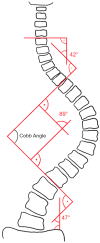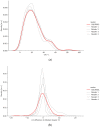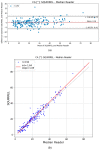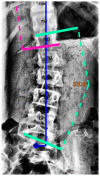Fully Automated Measurement of Cobb Angles in Coronal Plane Spine Radiographs
- PMID: 39064162
- PMCID: PMC11278017
- DOI: 10.3390/jcm13144122
Fully Automated Measurement of Cobb Angles in Coronal Plane Spine Radiographs
Abstract
Background/Objectives: scoliosis is a three-dimensional structural deformity characterized by lateral and rotational curvature of the spine. The current gold-standard method to assess scoliosis is the measurement of lateral curvature of the spine using the Cobb angle in coronal plane radiographs. The interrater variability for Cobb angle measurements reaches up to 10°. The purpose of this study was to describe and assess the performance of a fully automated method for measuring Cobb angles using a commercially available artificial intelligence (AI) model trained on over 17,000 images, and investigate its interrater/intrarater agreement with a reference standard. Methods: in total, 196 AP/PA full-spine radiographs were included in this study. A reference standard was established by four radiologists, defined as the median of their Cobb angle measurements. Independently, an AI-based software, IB Lab SQUIRREL (version 1.0), also performed Cobb angle measurements on the same radiographs. Results: after comparing the readers' Cobb angle end vertebrae selection to the AI's outputs, 194 curvatures were considered valid for performance assessment, displaying an accuracy of 88.58% in end vertebrae selection. The AI's performance showed very low absolute bias, with a mean difference and standard deviation of differences from the reference standard of 0.16° ± 0.35° in the Cobb angle measurements. The ICC comparing the reference standard and the AI's measurements was 0.97. Conclusions: the AI model demonstrated good results in the determination of end vertebrae and excellent results in automated Cobb angle measurements compared to radiologists and could serve as a reliable tool in clinical practice and research.
Keywords: artificial intelligence; deep learning; machine learning; scoliosis; spinal asymmetry; spinal deformity.
Conflict of interest statement
C.L. is a researcher in a funded project (grant number LS20-020) and an employee of ImageBiopsy Lab. S.N. is a member of the medical advisory board for ImageBiopsy Lab. All other authors declare no conflicts of interest. The funders had no role in the design of the study, in the collection, analyses, or interpretation of data, in the writing of the manuscript, or in the decision to publish the results.
Figures







Similar articles
-
Use of Artificial Intelligence in Cobb Angle Measurement for Scoliosis: Retrospective Reliability and Accuracy Study of a Mobile App.J Med Internet Res. 2024 Nov 1;26:e50631. doi: 10.2196/50631. J Med Internet Res. 2024. PMID: 39486021 Free PMC article.
-
Comparison of spinal curvature parameters as determined by the ZEBRIS spine examination method and the Cobb method in children with scoliosis.PLoS One. 2018 Jul 9;13(7):e0200245. doi: 10.1371/journal.pone.0200245. eCollection 2018. PLoS One. 2018. PMID: 29985957 Free PMC article.
-
3D ultrasound imaging provides reliable angle measurement with validity comparable to X-ray in patients with adolescent idiopathic scoliosis.J Orthop Translat. 2021 May 19;29:51-59. doi: 10.1016/j.jot.2021.04.007. eCollection 2021 Jul. J Orthop Translat. 2021. PMID: 34094858 Free PMC article.
-
Intra- and Interrater Reliability of Cobb Angle Measurements on the Plane of Maximum Curvature Using Ultrasound Imaging Method.Spine Deform. 2019 Jan;7(1):18-26. doi: 10.1016/j.jspd.2018.06.015. Spine Deform. 2019. PMID: 30587314
-
Deep learning algorithm for automatically measuring Cobb angle in patients with idiopathic scoliosis.Eur Spine J. 2024 Nov;33(11):4155-4163. doi: 10.1007/s00586-023-08024-5. Epub 2024 Feb 17. Eur Spine J. 2024. PMID: 38367024 Review.
References
Grants and funding
LinkOut - more resources
Full Text Sources
Miscellaneous

